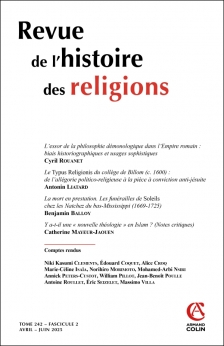
REVUE DE L'HISTOIRE DES RELIGIONS (2/2025)
Pour acheter ce numéro, contactez-nous
Recevez les numéros de l'année en cours et accédez à l'intégralité des articles en ligne.
La Nef de l’Église connut de multiples déclinaisons dans les arts visuels au temps de la Contre-Réforme. Parmi celles-ci, le Typus Religionis, une « allégorie de la Religion », assimile l’Institution au seul clergé régulier, jésuites en tête. Polémique dès l’époque de sa création, le sujet n’a suscité l’émoi qu’à la découverte d’un immense tableau au collège de Billom en 1762. Retenu comme pièce à conviction dans le cadre du procès intenté à la Compagnie de Jésus en France, cette oeuvre invite à questionner la « normativité » d’une image religieuse et politique sous l’Ancien Régime. L’analyse portera sur ses significations et les étapes de son élaboration à partir d’une riche tradition allégorique. Elle montrera les ressorts d’un détournement iconographique exemplaire à des fins d’autocélébration.
At the time of the Counter-Reformation, the treatment of the Nave of the Church had many variations in the visual arts. Among these, the Typus Religionis, an “allegory of Religion”, assimilates the Institution solely to the regular clergy, led by the Jesuits. Although it was criticised from the time of its creation, this allegory stirred up a storm only when a huge painting was discovered at the College of Billom in 1762. Used as evidence in the trial brought against the Society of Jesus in France, this work invites us to question the “normativity” of a religious and political image under the Ancien Régime. The analysis here focuses on the meanings of this work and the stages of its development, based on a rich allegorical tradition. This study shows the ways in which an exemplary iconographic diversion was used for purposes of self-celebration.

